
AI Fundraising for Nonprofits: Embracing the New Frontier
Embracing change and adapting to new trends is crucial for long-term nonprofit fundraising success. Nonprofits everywhere have experience in improving how they fundraise. For instance, in the last 10-15 years, your organization has likely pivoted to online fundraising methods. More recently, you learned how to effectively connect with and engage donors and other supporters during the COVID-19 pandemic.
But the technological frontier keeps advancing, and the newest trend on the nonprofit horizon is artificial intelligence (AI) fundraising. With AI, your organization can automate mundane tasks, gain deeper insight into who your supporters are, and ultimately, raise more for your mission.
However, AI fundraising does have a bit of a learning curve. To help, we’ve created this guide to help you embrace the new technological frontier in your operations. Here’s what we’ll cover:
- Getting Up To Speed: The Basics of AI for Fundraising
- 9 Ways to Tap Into AI Fundraising
- A Note On Using AI Responsibly
- 5 Tips for Choosing an AI Fundraising Tool
- DonorSearch: The Best Nonprofit AI Fundraising Tool
By embracing AI fundraising, your nonprofit is embracing a brighter future. Let’s get started!

Getting Up To Speed: The Basics of AI for Fundraising
Getting the most out of AI fundraising for your organization will require some basic knowledge of what AI is, how it works, and how it can apply to the world of fundraising. Let’s go over some essentials.
What is AI and how does it work?
AI is a computer’s ability to “think” like a human does. With this knowledge, AI tools can perform tasks like processing and analyzing data or generating content with a high level of accuracy and efficiency.
As you learn about AI, you’ll likely come across the term “machine learning.” This refers to the process an AI tool goes through to gain its intelligence and improve that intelligence over time. Machine learning typically involves processing a large amount of data through a mathematical model called an algorithm. For instance, the popular generative AI tool ChatGPT gained its knowledge by processing a large dataset of text from books, articles, and internet content.
It’s important to note that while AI tools are built to have human-like intelligence, they’re not sentient or autonomous tools, and they aren’t able to replicate human emotion or bring personal experiences to their insights. That’s why it’s important to retain the human touch any time your nonprofit uses AI (more on this later).
The 2 Types of AI Tools
In the nonprofit space, you’ll typically come across two types of AI tools:
- Generative AI: These tools create written or visual content in response to prompts. ChatGPT is an example of a generative AI tool, as is DALL-E, which generates images.
- Predictive AI: Predictive AI tools process and analyze datasets to generate predictions or suggestions for the future. For instance, DonorSearch Ai is a predictive AI tool that helps nonprofits predict who is most ready and willing to give.
Neither type of tool is better than the other; they simply do different things and can help your nonprofit with different tasks!
What role does AI play in fundraising?
There are dozens of ways AI can help your nonprofit improve its fundraising strategy (see specific use cases below). But at the end of the day, what AI can really do for your nonprofit is help you to:
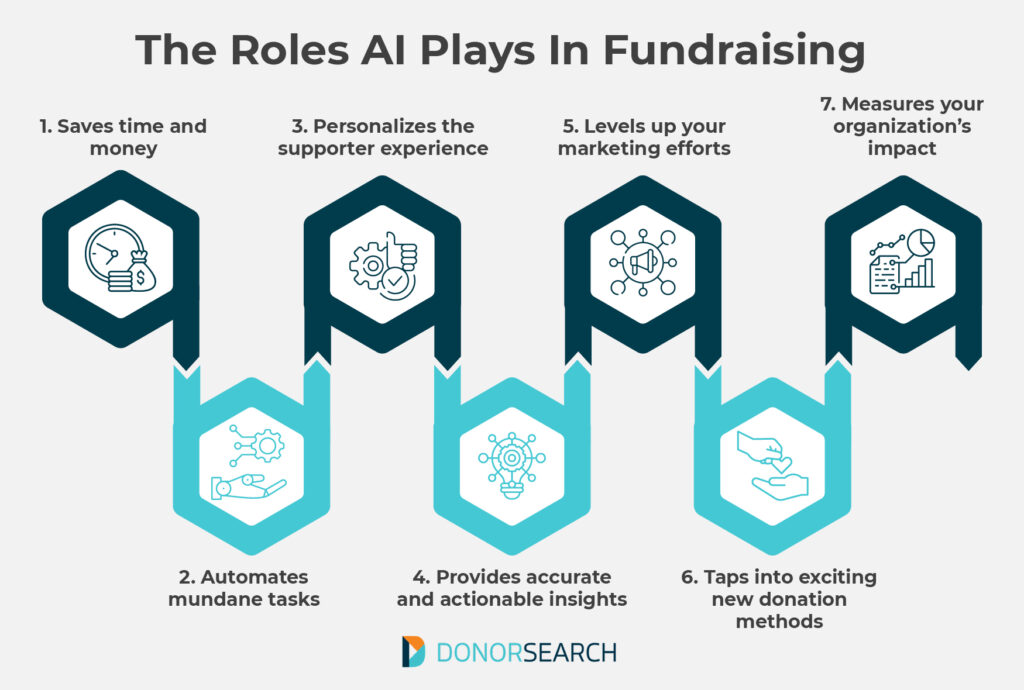
- Save time and money
- Automate mundane tasks to focus on more important work
- Personalize the supporter experience
- Provide accurate and actionable insights
- Level up your marketing efforts
- Tap into exciting new donation methods
- Measure your organization’s impact and set achievable goals
Think of AI tools as another member of your nonprofit’s team. The right tools ultimately increase your organization’s capacity to do more good for your community by bringing new insights and capabilities to the table.
How commonly are nonprofits using AI in fundraising?
As noted in The Chronicle of Philanthropy, Nathan Chapell, senior vice president of DonorSearch, pointed out that less than 30% of nonprofits have started using or exploring AI. This means that your organization has an opportunity to get ahead of the game and stand out from the crowd by embracing AI fundraising and all that it has to offer!
9 Ways to Tap Into AI Fundraising
Now that you know the basics of AI fundraising, you’re probably wondering how you can get started. Begin by considering nine different use cases for AI in fundraising:
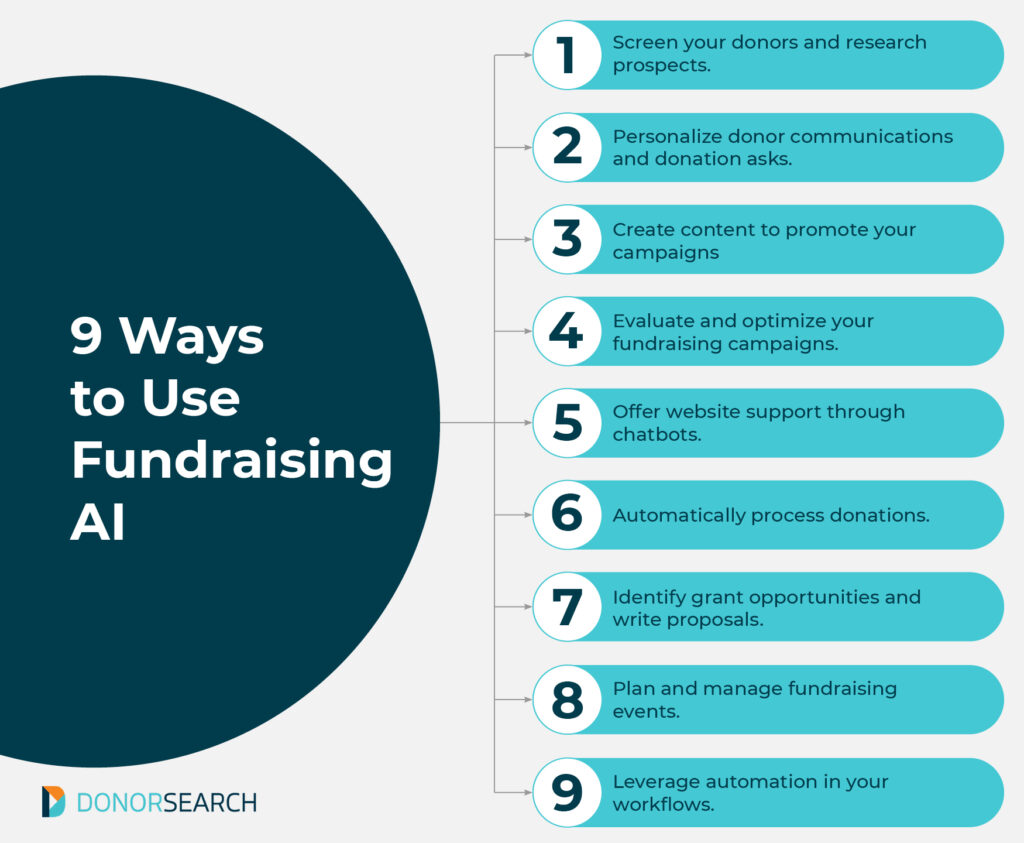
1. Screen your donors and research prospects.
An important aspect of fundraising is being confident in your donation asks. Knowing who is ready and willing to give helps you to raise money more efficiently, build relationships with key players in your community, and ultimately reach your funding goals quicker.
One of the best ways to use AI in fundraising is to leverage an AI-powered prospecting and screening tool, like DonorSearch Ai. A tool like this can use your organization’s data to help you find donors and prospects who have the capacity, affinity, and propensity that indicate they’re ready to give.
Here’s how it works:
- Your data is combined with information from trustworthy external datasets (such as engagement behavior, giving capacity, and social media activity).
- With all the right data in one place, you’ll have a holistic view of your donors and prospects and can identify affinity, capacity, and propensity markers.
- The AI capabilities in the tool make specific predictions and recommendations about each individual, such as who is likely to give a donation over a certain amount or within the next year.
With the data-driven insights on your side, you can take on donor cultivation and stewardship tasks with confidence, designing strategies that you know will resonate with your supporters.
2. Personalize donor communications and donation asks.
More and more, nonprofit supporters are expecting a high level of personalization from the organizations they support. They want to feel seen and valued for their contributions, and they want the nonprofits they care about to meet them where they’re at.
With AI fundraising tools, you can quickly and easily personalize your donor communications. For instance, you might use predictive AI tools to learn about your supporters’ communication preferences and what they’re most likely to respond to. From there, you can segment supporters into groups based on similar preferences or demographics. Then, you can use generative AI tools to help you create messages that you can personalize.
This can be a helpful strategy for tailoring your donation asks, as well. Each donor will want to be asked to give in a way that appeals to them. One major donor might prefer an in-person meeting, for example, while another might want a written letter. Using AI to learn about individuals’ needs and expectations means that you can more easily scale your efforts and ensure everyone in your community is communicated with in a way that they like.
3. Create content to promote your campaigns.
No matter how long you’ve been fundraising, you know that half the battle is spreading the news about your campaigns. Sometimes it can be hard to find the words, visuals, or formats that connect with your audience and encourage participation.
This is another instance in which generative AI can be especially helpful. Say you’re planning your end-of-year campaign. You could use a tool like ChatGPT to outline an email stream for mid-level donors or to draft different versions of one announcement to go on multiple social media platforms.
When using AI to create content, however, just remember to always have a human member of your team edit the tool’s outputs. This will help ensure that you have a chance to direct the tone and voice of your messages so that they align with your brand.
4. Evaluate and optimize your fundraising campaigns.
Part of being an effective fundraiser is learning from past successes and challenges. AI can help you evaluate past fundraising campaigns by examining:
- Campaign data, producing metrics that show key patterns and trends
- Campaign budgets, helping you determine how to allocate future funds to achieve the greatest ROI
- Supporter feedback, giving you insight into how your community perceived past campaigns and how they might react to future strategies
- Donor journeys during past campaigns, letting you identify the most effective channels for promotion and the best tools for raising money
When you’re able to turn a critical eye to your past fundraising campaigns, you can see what has and hasn’t worked and make plans for more success in the future.
5. Offer website support through chatbots.
Imagine someone decides to donate on your organization’s website outside of business hours. They arrive on the donation page intending to give generously, but in the middle of the donation process, they have a question that halts their progress. With no one to get in touch with, they abandon your form, saying they’ll come back later.
You can avoid situations like this by using an AI-powered chatbot on your website. These bots can answer common questions for your website visitors and direct them where to go to find the resources or information they’re looking for.
The great thing about a chatbot is that it’s there around the clock, ready to help your website visitors whenever they decide to visit your site.
6. Automatically process donations.
Some AI tools can help your nonprofit process payments securely, capture important donor information, generate tax receipts, attribute donations to specific campaigns or programs, and even detect fraudulent activity.
By using AI to help you manage the flow of donations to your nonprofit, you can ensure that your organization remains financially compliant, uses donations for their intended purposes, and has plenty of time to focus on recognizing and stewarding donors, all while avoiding the risk of human error.
7. Identify grant opportunities and write proposals.
Grants are an important source of funding for nonprofits, but it takes time to identify opportunities that your organization is eligible for and to write proposals for each grant.
AI can speed up the process, helping you find grant opportunities along with their eligibility criteria and deadline information. Some tools can even help you draft your proposals according to proposal guidelines and give you suggestions for ensuring your organization stands out from the crowd.
8. Plan and manage fundraising events.
Fundraising events are a chance for your community to come together, participate in fun activities, make memories, and give generously. But planning a successful event is often easier said than done.
AI can help you:
- Choose the right date and venue
- Set your event budget
- Create promotional materials
- Make your guest list
An AI tool built for events can also help you gather and analyze attendee feedback after your event is over. Then you’ll have insight into what your attendees liked and disliked about your event so you can adjust your strategy in the future.
9. Leverage automation in your workflows.
One of the biggest selling points of AI technology is that it can save your team precious time and energy by automating the mundane tasks in your workflows such as data entry and data analysis, reading and responding to communications, managing your social media presence, taking notes in meetings, and more.
When you automate these “busywork” tasks, you have more time for the fundraising work that matters the most—identifying donors, developing relationships with them, issuing donation appeals, and continually engaging your supporters in your work.
A Note on Using Fundraising AI Responsibly
Though there are a wide range of ways for nonprofits to use AI and the benefits abound, many people are still concerned about the impact it could have on society.
For instance, there are still unanswered questions about how AI affects personal privacy and security and how it perpetuates bias and discrimination. Additionally, some worry that an increased dependence on technology will negatively impact the human workforce.
In order for your nonprofit to tap into the benefits of using AI while still maintaining trust with its community and internal team, you need to be aware of these concerns and commit to using fundraising AI responsibly at your organization.
Using AI responsibly means that your organization adopts and uses AI technology in a way that promotes privacy, security, ethics, inclusiveness, accountability, and transparency. The idea of using AI responsibly comes from the Responsible AI Framework developed by the Fundraising.AI collaborative. The main tenets of the framework are:
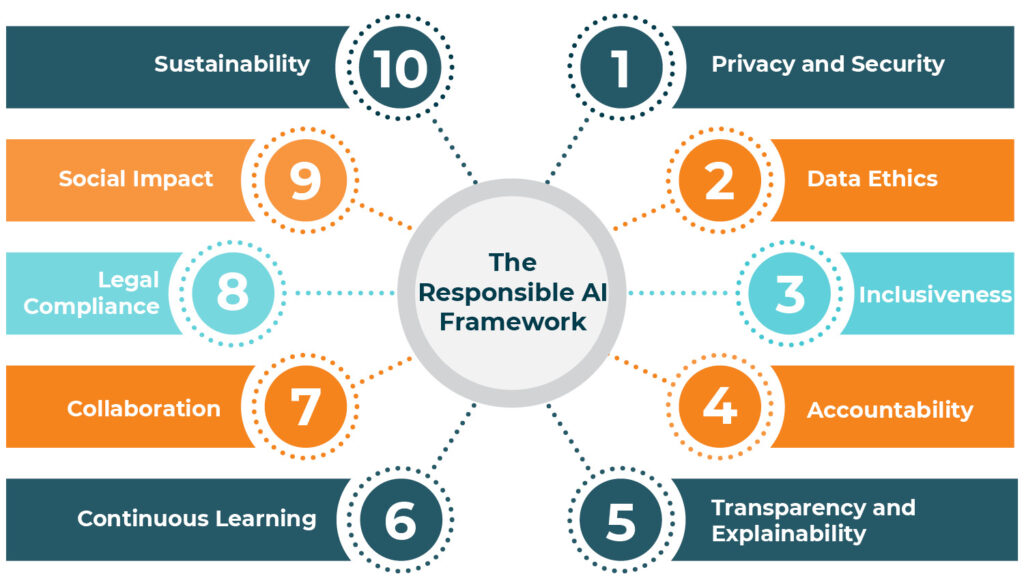
- Privacy and security
- Data ethics
- Inclusiveness
- Accountability
- Transparency and explainability
- Continuous learning
- Collaboration
- Legal compliance
- Social impact
- Sustainability
Continuous learning will be especially important as you get started with AI fundraising. Because AI tools are the new frontier for nonprofits, we’re still learning about them, and it’s up to you to stay on top of best practices and keep an eye out for updates in the AI regulatory landscape. This will help ensure your nonprofit gets the most mileage out of its tools while doing right by your community.
5 Tips for Choosing an AI Fundraising Tool
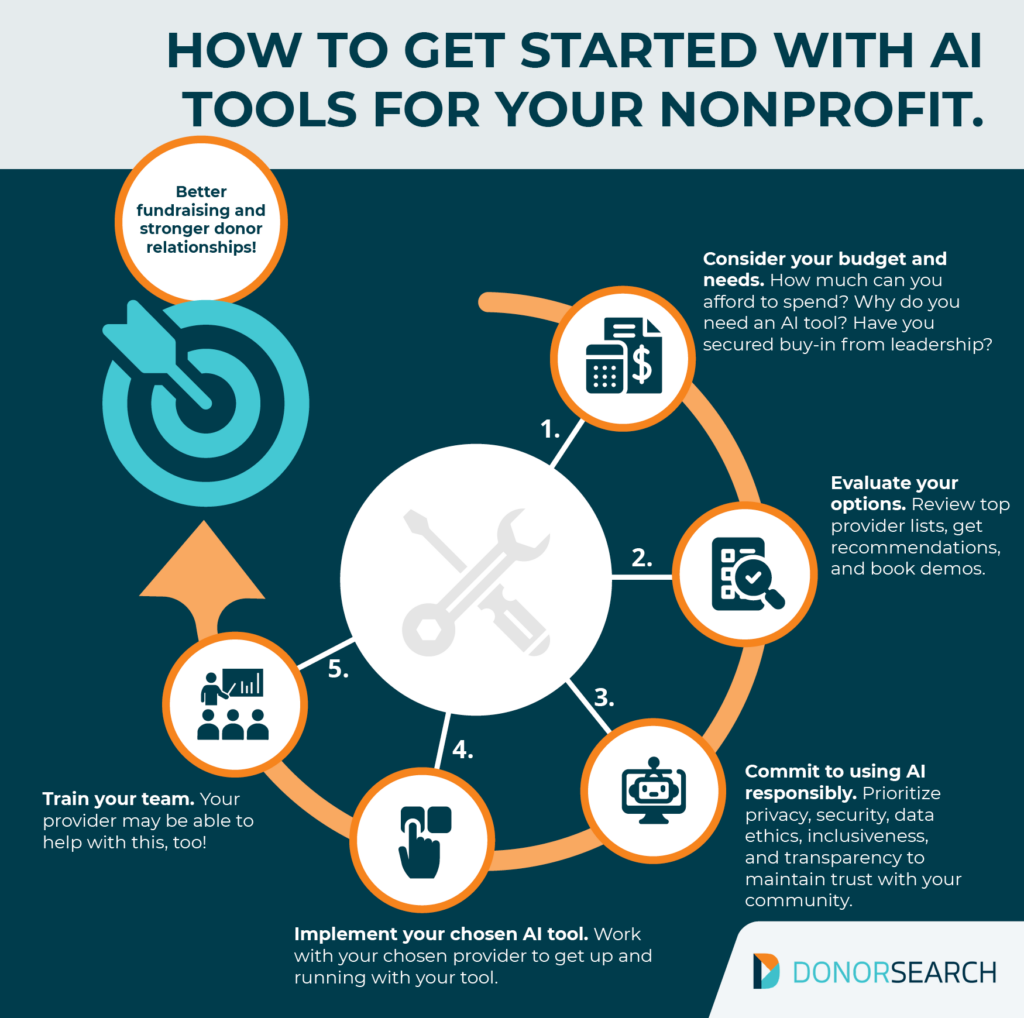
Now that you’re up to speed on what fundraising AI is, how you can use it, and the main things to keep in mind in order to use it responsibly, you’re likely ready to begin shopping for your own tool. Follow these steps to ensure you invest in a tool that will help you achieve the greatest ROI for your mission while meeting all of your organization’s needs:
- Determine your needs and budget. Before you start looking at different tools or providers, take a moment to determine the goals your organization has for using AI in its fundraising strategy. For instance, maybe you want to strengthen your major giving program or submit more grant proposals. Also, decide how much money you’re comfortable investing into your tool.
- Identify and evaluate your options. Next, review lists of top AI fundraising tools or ask trusted nonprofit colleagues for their recommendations. Make sure you read up on each tool, its features, and its pricing model. Take into account any reviews from current users. You should also look into the providers you’re considering. Make sure their values align with your nonprofit’s.
- Commit to using AI responsibly. Remember, how you use AI matters. Before adopting a tool, consider creating an AI policy for your entire organization to follow, outlining how you’ll maximize the benefits and minimize the risks associated with using AI for fundraising. You’ll want to share this with your community in the spirit of transparency and trust.
- Implement your AI tool. Once you’ve chosen the AI fundraising tool you want, it’s time to get up and running with it. Work with your provider to understand the ins and outs of each feature and ask questions as needed so you can integrate the tool into your workflows without a hitch.
- Train your team. Train your staff members on how to use your chosen tool, working with your provider as needed. Make sure to emphasize that the goal of using AI in your fundraising strategy is to make your processes more streamlined and efficient so you can focus on the more human aspects of nonprofit work.
Shopping for an AI fundraising tool isn’t just a one-time investment; it’s a fundamental shift in how your nonprofit works to raise money for its mission. Use the shopping experience as an opportunity to position your organization to get the most out of its chosen tool and to begin using AI in an ethical way from the beginning.
DonorSearch: The Best Nonprofit AI Fundraising Tool
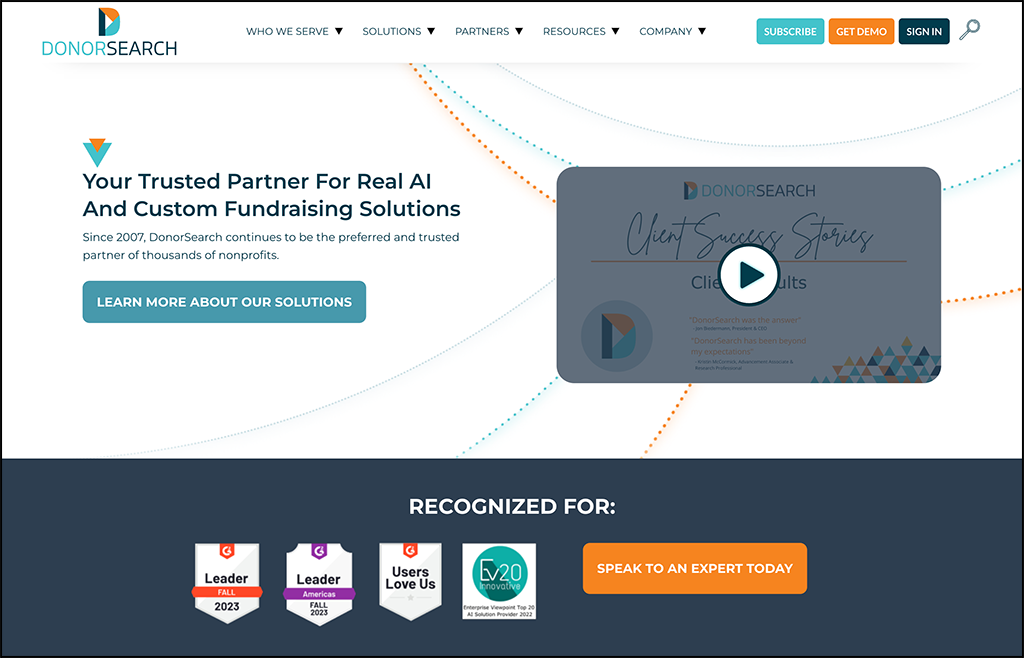
DonorSearch Ai is the most advanced AI and machine learning tool for nonprofits. Using predictive modeling, DonorSearch Ai can help your nonprofit identify donors and prospects who are willing and ready to give, providing you with specific predictions and recommendations about individuals to guide your outreach and fundraising work.
Here’s how it works:
- Your nonprofit provides DonorSearch with access to its donor data.
- DonorSearch integrates your donor data with its high-quality external datasets, all while maintaining a high level of security.
- The tool screens the data provided to identify donors and prospects with affinity, propensity, and capacity markers.
- DonorSearch Ai then uses predictive modeling to provide specific predictions about individual prospects and donors, such as who will give in the next year or who is likely to make a recurring gift.
With accurate insights from DonorSearch Ai on your side, your team can be confident going into the outreach and donation appeal processes, knowing that you have the information you need to design strategies that will resonate with your donors and encourage them to give generously.
Want to learn more? Check out our DonorSearch Ai explainer video to hear from some of our team members about how we’re taking fundraising to the next level:
Final Thoughts
Throughout the history of nonprofit work, organizations have learned to embrace new technology in order to do their work in more efficient and effective ways. Now, nonprofits are exploring a new frontier—the world of fundraising AI. Use the information in this guide to determine how your organization will tap into these new technologies and use them to do more good!
Want to keep reading? Check out these recommended resources:
- Fundraising for Healthcare Institutions: The Basics to Know. If you’re fundraising for a healthcare institution, there are several special factors you need to keep in mind in order to be successful. Learn what they are in this guide.
- Grateful Patient Programs: 3 FAQs & How to Get Started. Is your healthcare organization considering starting up a grateful patient program? Learn how to get a strong start.
- University Fundraising: 5 Flawless Tips to Engage Alumni. Fundraising for your university depends on how well you can connect with and engage your alumni. Get our top tips in this guide.

